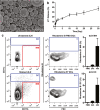A therapeutic microparticle-based tumor lysate vaccine reduces spontaneous metastases in murine breast cancer
- PMID: 25224145
- PMCID: PMC4389752
- DOI: 10.1208/s12248-014-9662-z
A therapeutic microparticle-based tumor lysate vaccine reduces spontaneous metastases in murine breast cancer
Abstract
Metastatic breast cancer is currently incurable, and available therapies are associated with severe toxicities. Induction of protective anti-tumor immunity is a promising therapeutic approach for disseminated breast cancer, as immune responses are (i) systemic; (ii) antigen-specific; and (iii) capable of generating long-lived "memory" populations that protect against future tumor recurrences. Pursuant with this approach, we have developed a novel heterologous prime/boost vaccination regimen that reduces spontaneous lung metastases in mice with established murine 4T1 adenocarcinoma breast tumors. In our studies, mice were orthotopically challenged with luciferase-expressing 4T1 tumor cells; luciferase expression was retained in vivo, enabling us to quantitatively track metastatic tumor growth via bioluminescent imaging. On day 6 post-challenge, mice received a therapeutic "prime" consisting of bulk tumor lysates encapsulated in poly(lactic-co-glycolic) acid (PLGA) microparticles (MPs). On day 11, mice received a "boost" composed of free tumor lysates plus a cocktail of Toll-like receptor (TLR)-stimulating adjuvants. Tumor progression was monitored in vaccinated and untreated mice for 25 days, a time at which 100% of untreated mice had detectable lung tumors. PLGA MPs injected subcutaneously trafficked to draining lymph nodes and were efficiently phagocytosed by dendritic cells (DCs) within 48 h. Our combination therapy reduced metastatic lung tumor burdens by 42% and did not induce autoimmunity. These findings illustrate that vaccines based upon MP delivery of tumor lysates can form the basis of an effective treatment for metastatic breast cancer and suggest that similar approaches may be both efficacious and well-tolerated in the clinic.
Figures





Similar articles
-
Biotinylated Streptavidin Surface Coating Improves the Efficacy of a PLGA Microparticle-Based Cancer Vaccine.Bioconjug Chem. 2020 Sep 16;31(9):2147-2157. doi: 10.1021/acs.bioconjchem.0c00347. Epub 2020 Aug 31. Bioconjug Chem. 2020. PMID: 32786363 Free PMC article.
-
Surrogate tumor antigen vaccination induces tumor-specific immunity and the rejection of spontaneous metastases.Cancer Res. 2005 Apr 1;65(7):2938-46. doi: 10.1158/0008-5472.CAN-04-2874. Cancer Res. 2005. PMID: 15805297
-
Immune stimulatory antigen loaded particles combined with depletion of regulatory T-cells induce potent tumor specific immunity in a mouse model of melanoma.Cancer Immunol Immunother. 2009 Apr;58(4):517-30. doi: 10.1007/s00262-008-0574-6. Epub 2008 Aug 22. Cancer Immunol Immunother. 2009. PMID: 18719913 Free PMC article.
-
PLGA nanoparticle-mediated delivery of tumor antigenic peptides elicits effective immune responses.Int J Nanomedicine. 2012;7:1475-87. doi: 10.2147/IJN.S29506. Epub 2012 Mar 15. Int J Nanomedicine. 2012. PMID: 22619507 Free PMC article.
-
Enhanced stimulation of anti-breast cancer T cells responses by dendritic cells loaded with poly lactic-co-glycolic acid (PLGA) nanoparticle encapsulated tumor antigens.J Exp Clin Cancer Res. 2016 Oct 26;35(1):168. doi: 10.1186/s13046-016-0444-6. J Exp Clin Cancer Res. 2016. PMID: 27782834 Free PMC article.
Cited by
-
Nanoparticle-Based Delivery of CRISPR/Cas9 Genome-Editing Therapeutics.AAPS J. 2018 Oct 10;20(6):108. doi: 10.1208/s12248-018-0267-9. AAPS J. 2018. PMID: 30306365 Free PMC article. Review.
-
Nanomaterials for cancer immunotherapy.Biomaterials. 2017 Dec;148:16-30. doi: 10.1016/j.biomaterials.2017.09.017. Epub 2017 Sep 17. Biomaterials. 2017. PMID: 28961532 Free PMC article. Review.
-
Nanoparticles: augmenting tumor antigen presentation for vaccine and immunotherapy treatments of cancer.Nanomedicine (Lond). 2017 Dec;12(23):2693-2706. doi: 10.2217/nnm-2017-0254. Epub 2017 Nov 3. Nanomedicine (Lond). 2017. PMID: 29098928 Free PMC article. Review.
-
A simple, clinically relevant therapeutic vaccine shows long-term protection in an aggressive, delayed-treatment B lymphoma model.JCI Insight. 2017 Nov 16;2(22):e92522. doi: 10.1172/jci.insight.92522. eCollection 2017 Nov 16. JCI Insight. 2017. PMID: 29202455 Free PMC article.
-
Evaluation of a Particulate Breast Cancer Vaccine Delivered via Skin.AAPS J. 2019 Jan 2;21(2):12. doi: 10.1208/s12248-018-0285-7. AAPS J. 2019. PMID: 30604321
References
-
- DeSantis C, Ma J, Bryan L, Jemal A. Breast cancer statistics, 2013. CA: Cancer J Clin. 2014;64(1):52–62. - PubMed
Publication types
MeSH terms
Substances
Grants and funding
LinkOut - more resources
Full Text Sources
Other Literature Sources
Medical

